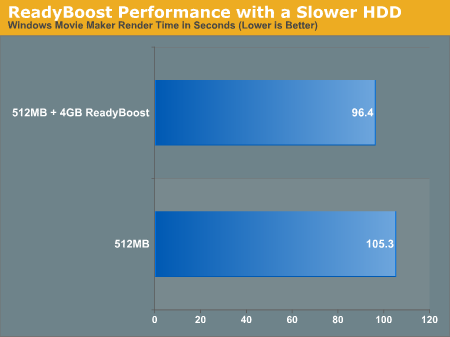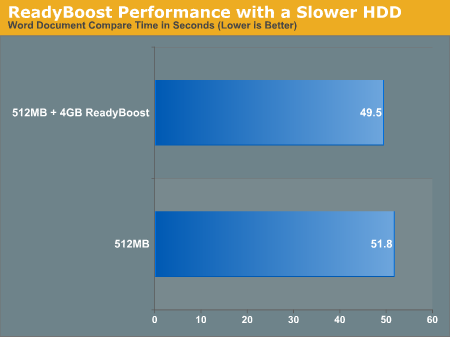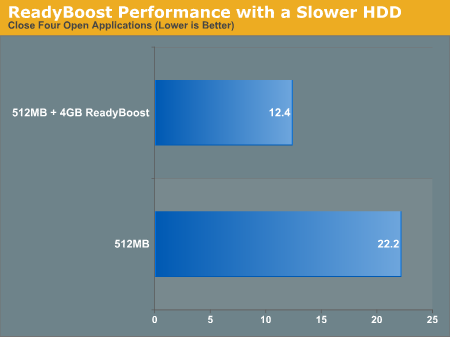Impact of Drive Performance on ReadyBoost
For our ReadyBoost tests we used a modern hard drive, a Western Digital 500GB drive. We wanted to find out if ReadyBoost had an even greater impact if your system has a slower drive, so we switched to a five-year old Western Digital WD1000 100GB drive to see how ReadyBoost's impact changed, if at all. We took three benchmarks - the Movie Maker, Word, and Application Close tests - and ran them on the WD1000 to compare performance scaling with ReadyBoost.



ReadyBoost doesn't seem to do any better with a slower hard drive, although we'd suspect that you may see bigger gains on similarly old notebook drives.
ReadyDrive
The last I/O feature before we get to networking is ReadyDrive, a technology that is closely related to ReadyBoost. Whereas ReadyBoost is designed for use with external flash memory, ReadyDrive is based around internal flash memory, which has been cropping up in recent years in so-called hybrid drives (hard drives featuring large amounts of flash memory as a cache) and with Intel's Robson technology (which puts flash memory right on the motherboard). In both of these cases this internal flash memory has the added advantage of being unremovable and hence more reliable (as a USB flash drive could be removed at any second along with its cached data), which opens up a few more uses of flash memory as a cache.
On top of the standard caching uses to improve general performance, ReadyDrive can use this internal flash memory as a way to improve hibernation recovery and boot times, as flash memory could be a faster non-volatile data storage than a hard drive. Use of this flash memory also stands to reduce average hard drive power usage (a particularly important item for notebooks), as caching of data can allow Vista to spin the hard drive down more often. Finally, integrated flash devices are likely to be faster overall than most external flash drives, for a couple of reasons. First, pulling data over a USB connection tends to require a bit more work. Second, we would expect most integrated flash devices to use higher performance flash memory.
Coming up with tests for ReadyBoost was a bit tricky, but testing ReadyDrive is even more so. Besides creating some reasonable test scenarios, you also need hardware that supports ReadyDrive. It is also likely that various ReadyDrive devices will offer differing levels of performance. For these reasons, we will hold off on trying to benchmark ReadyDrive for a future article.
For our ReadyBoost tests we used a modern hard drive, a Western Digital 500GB drive. We wanted to find out if ReadyBoost had an even greater impact if your system has a slower drive, so we switched to a five-year old Western Digital WD1000 100GB drive to see how ReadyBoost's impact changed, if at all. We took three benchmarks - the Movie Maker, Word, and Application Close tests - and ran them on the WD1000 to compare performance scaling with ReadyBoost.



ReadyBoost doesn't seem to do any better with a slower hard drive, although we'd suspect that you may see bigger gains on similarly old notebook drives.
ReadyDrive
The last I/O feature before we get to networking is ReadyDrive, a technology that is closely related to ReadyBoost. Whereas ReadyBoost is designed for use with external flash memory, ReadyDrive is based around internal flash memory, which has been cropping up in recent years in so-called hybrid drives (hard drives featuring large amounts of flash memory as a cache) and with Intel's Robson technology (which puts flash memory right on the motherboard). In both of these cases this internal flash memory has the added advantage of being unremovable and hence more reliable (as a USB flash drive could be removed at any second along with its cached data), which opens up a few more uses of flash memory as a cache.
On top of the standard caching uses to improve general performance, ReadyDrive can use this internal flash memory as a way to improve hibernation recovery and boot times, as flash memory could be a faster non-volatile data storage than a hard drive. Use of this flash memory also stands to reduce average hard drive power usage (a particularly important item for notebooks), as caching of data can allow Vista to spin the hard drive down more often. Finally, integrated flash devices are likely to be faster overall than most external flash drives, for a couple of reasons. First, pulling data over a USB connection tends to require a bit more work. Second, we would expect most integrated flash devices to use higher performance flash memory.
Coming up with tests for ReadyBoost was a bit tricky, but testing ReadyDrive is even more so. Besides creating some reasonable test scenarios, you also need hardware that supports ReadyDrive. It is also likely that various ReadyDrive devices will offer differing levels of performance. For these reasons, we will hold off on trying to benchmark ReadyDrive for a future article.










105 Comments
View All Comments
Zak - Thursday, February 1, 2007 - link
I've finally got around to installing RC2 last week: Dell Inspiron 2GHz CoreDuo, 2GB RAM, 7200RPM HD, 256 Nivdia video. Vista is slow, network transfers are 50% slower or so than in XP, GUI is sluggish and all the improvements are pretty annoying. Interface is too busy and overdone. A simple copy message contains a long unnecessary explanation of what's about to happen. Even after turning off the security features one can't escape the annoying popups and messages. And my hard drive was crunching non-stop all day, I can't even imagine what it does to battery life. I haven't had a virus or spyware in years and I don't see any compelling reasons to switch to Vista. I haven't even tried any multimedia features as none of my DVD and video playback software worked properly and I will not use WMP if my life depended on it, so I can't comment nt on DRM and stuff but I've had enough after few days and restored my XP image back to the laptop. If MS tries to force this on people as its, without major improvements, I see Apple and Linux getting lots of switchers. But them XP was bad at first too so maybe Vista will become usable with SP2:) I myself will desperately look for an alternative to Vista. I don't play games that much any more so this won't be "a must" for me.Z.
Zebo - Thursday, February 1, 2007 - link
I'm very afraid Zak. I will upgrade due to Microsoft forcing the issue on us gamers with dx10 vista only but with total dread. I may have to start listening to those console fans and linux fans after all. But the lack of TBS games kills consoles for me...SIGH..I totally agree with you about Virus and spy/malware issues. All are resolved or blocked with free third party apps many years now for anyone with the slightest clue. Same goes for Firewall/searching and other features MS lists on their "100 advantages" site. Vista is just late to the party with what we all know how to do and cripples your computer performance and makes everything so dumbed down visually and practically.
mlambert890 - Saturday, February 3, 2007 - link
You guys must be using a different OS. I havent heard of anyone with this dismal of an experience at all. If you hate the UI, just run it in legacy mode and it will look like XP. Disable all of the security add ins and they ARE gone. Ive take a Vista machine and set it up to the point that the person using it had no real clue it was Vista but did notice that their laptop seemed quicker.Have fun on Linux though. Linux is a LOT easier to use/live with than any MS OS! (I need an eyeroll smiley here)
jonp - Monday, February 5, 2007 - link
I would be interested to know if you have installed and worked with SUSE 10.2? as I assume your "...a LOT easier..." is sarcasm.kalrith - Thursday, February 1, 2007 - link
The second sentence of the third paragraph states, "The reason the low end AMD cards look better off here".I think you meant ATI instead of AMD.
kalrith - Thursday, February 1, 2007 - link
Another typo is in the last sentence on the first page. It says, "What's a question we hope to answer..." What's should be That's.JarredWalton - Friday, February 2, 2007 - link
Technically, ATI is now AMD, which is why we are now referring to the cards as AMD cards. Same thing as ATI, but since they were bought out.... :)kalrith - Friday, February 2, 2007 - link
You're right...I completely forgot about that.stash - Thursday, February 1, 2007 - link
WMDC was RTM'ed yesterday: http://www.microsoft.com/downloads/details.aspx?Fa...">http://www.microsoft.com/downloads/deta...0-af33-3...stash - Thursday, February 1, 2007 - link
Which common 3rd-party apps are you referring to here?